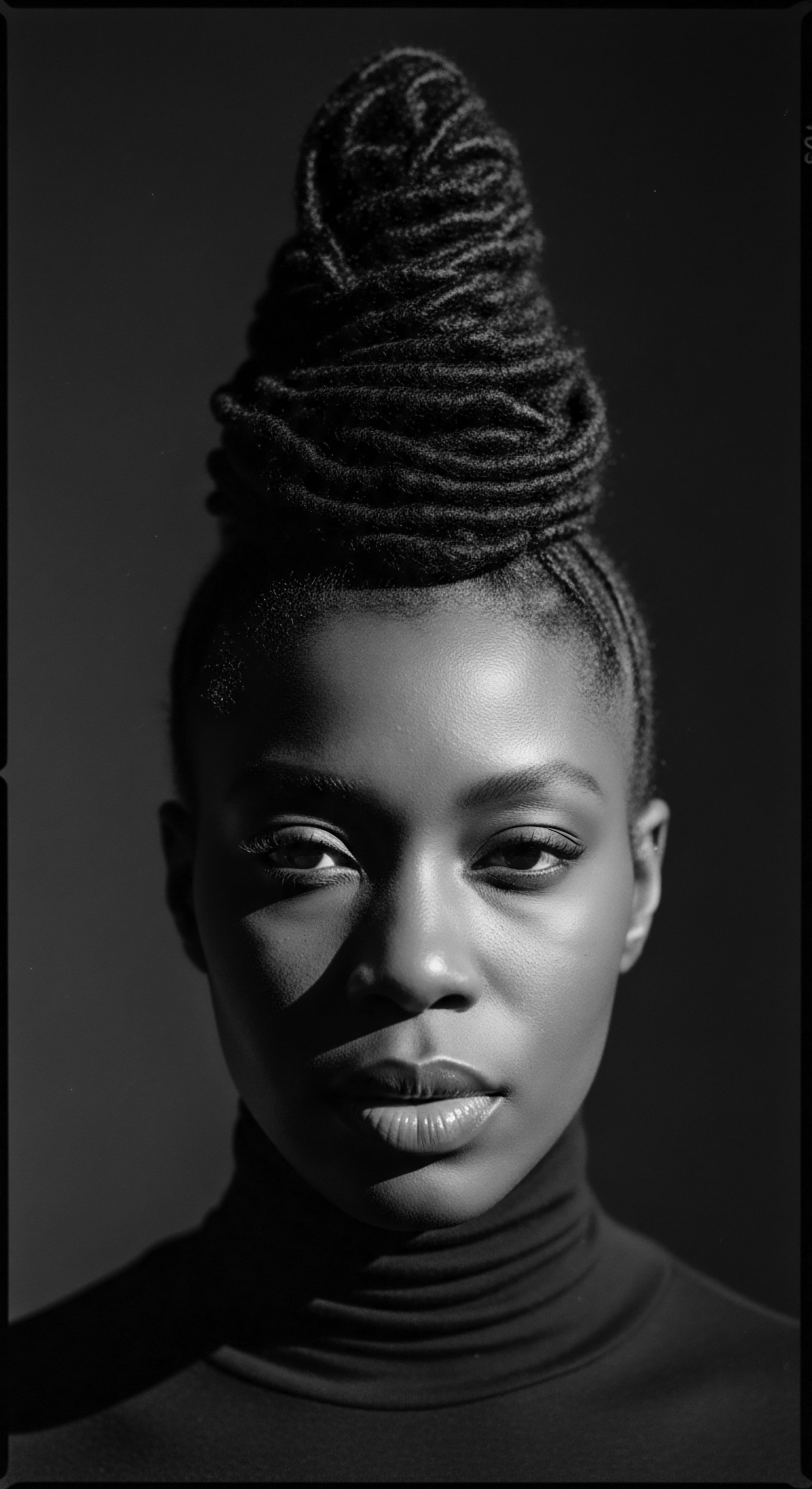
Fundamentals
The Buriti Palm, scientifically known as Mauritia flexuosa, stands as a majestic sentinel within the verdant embrace of South America’s tropical rainforests, particularly flourishing across the Amazon basin and the Brazilian Cerrado. This imposing palm, capable of reaching heights of 25 to 35 meters, possesses a solitary, cylindrical trunk crowned by a hemispherical canopy of vast, fan-shaped leaves. Its reddish-brown fruits, typically oval and measuring 3 to 5 centimeters, hold within their fibrous pulp a treasure of rich, orange-hued oil. This oil, extracted through cold pressing, is the primary reason for the Buriti Palm’s recognition, offering a potent blend of fatty acids, vitamins, and antioxidants.
The significance of the Buriti Palm extends far beyond its botanical classification, weaving into the very fabric of life for indigenous communities who have long revered it as the “Tree of Life” or “Ojidu” in the Warao language. This designation speaks volumes about its profound cultural meaning, providing not only sustenance through its edible fruit and grubs but also essential materials for shelter, handicrafts, and even fermented beverages. The tree’s pervasive presence and its generous yield have cemented its place as a cornerstone of traditional economies and daily existence for countless generations.

Physical Characteristics and Composition
The Buriti fruit yields an oil distinguished by its vibrant reddish-orange color, a visual testament to its abundant carotenoid content. This rich hue is indicative of beta-carotene, a precursor to vitamin A, which is present in remarkably high concentrations. Indeed, Buriti oil is celebrated as one of nature’s richest sources of beta-carotene, containing five times more of this vital compound than carrot oil. Beyond carotenoids, the oil is a repository of other beneficial elements, including tocopherols (vitamin E), ascorbic acid (vitamin C), and a spectrum of unsaturated fatty acids.
The fatty acid profile of Buriti oil reveals a composition that is particularly advantageous for both skin and hair. Oleic acid (Omega 9) is often the most prevalent, sometimes comprising as much as 64% of the oil’s content, contributing to its moisturizing and hydrating properties. Linoleic acid (Omega 6) and palmitic acid are also present, alongside smaller amounts of stearic acid and linolenic acid. This unique blend of fatty acids and vitamins bestows Buriti oil with strong antioxidant capabilities, aiding in the protection against free radical damage caused by environmental stressors like sun exposure and pollution.
The Buriti Palm, revered as a “Tree of Life” by indigenous communities, yields a potent oil rich in beta-carotene, vitamins, and fatty acids, making it a cornerstone of traditional life and natural care.

Traditional Uses and Cultural Context
For centuries, indigenous communities across the Amazon have recognized the Buriti Palm as a vital resource, integrating its various parts into their daily lives and cultural practices. The fruit itself is consumed raw, processed into flour, or fermented into alcoholic beverages. The pith from the leaf stalks finds use in crafting mats and paper, while the fibers from young leaves are meticulously transformed into ropes and hammocks. This comprehensive utilization underscores the palm’s central role in sustaining communities and preserving ancestral ways of life.
The oil, in particular, holds a cherished place in traditional beauty and wellness rituals. It has been historically applied to the skin to shield against the harsh tropical sun and to maintain healthy, lustrous hair. This ancestral wisdom, passed down through generations, highlights a deep understanding of the oil’s protective and nourishing qualities long before modern scientific validation. The practices surrounding the Buriti Palm exemplify a harmonious relationship with nature, where every element of the tree is honored and utilized with intention and respect for its inherent value.
- Food Source ❉ The fruit is eaten fresh, transformed into juice, or incorporated into various culinary preparations.
- Craft Materials ❉ Leaves and fibers are used to create hammocks, baskets, mats, and other household items.
- Traditional Medicine ❉ The oil and other parts of the palm have been used for healing and spiritual purposes.

Intermediate
The Buriti Palm’s meaning extends beyond its fundamental biological definition to encompass its profound role in shaping cultural practices and informing traditional understandings of wellness, particularly within the context of textured hair heritage. The oil extracted from its fruit is not merely a cosmetic ingredient; it is a legacy, a testament to ancestral knowledge, and a tangible link to the vibrant hair traditions of Black and mixed-race communities throughout the Amazon and beyond. This reddish-orange elixir carries within its very hue the stories of resilience and deep connection to the earth.

Echoes from the Source ❉ Ancestral Wisdom and Textured Hair
The history of Buriti oil in hair care is deeply intertwined with the ancestral wisdom of indigenous peoples and Afro-descendant communities in South America. For generations, these communities have understood the unique needs of textured hair, long before scientific laboratories began to dissect its complex structure. The application of Buriti oil, with its rich emollient properties, provided a natural solution for conditioning and protecting hair that was often exposed to challenging environmental conditions.
Traditional practices often involved using the oil to moisturize, add shine, and manage diverse hair textures, from tightly coiled curls to looser waves. The high concentration of fatty acids, such as oleic acid, allows the oil to penetrate the hair shaft, providing deep conditioning and helping to retain moisture. This capacity to limit water evaporation from the hair fiber was a critical aspect of ancestral hair care, particularly in humid climates where maintaining moisture balance was essential for hair health.
The oral traditions and communal rituals surrounding hair care served as vital conduits for transferring this knowledge. Elders, often the custodians of botanical wisdom, would guide younger generations in the proper harvesting and processing of Buriti fruit, emphasizing the reverence for the “Tree of Life” and its gifts. These practices were not merely functional; they were ceremonial, fostering a sense of community, identity, and continuity with the past. The communal act of preparing and applying hair treatments reinforced familial bonds and cultural belonging, creating a shared heritage of care.
Buriti oil is more than an ingredient; it is a cultural artifact, embodying ancestral wisdom for textured hair care and symbolizing the enduring legacy of communities connected to the Amazon.

The Tender Thread ❉ Buriti in Traditional Hair Rituals
The utilization of Buriti oil in traditional hair care rituals offers a profound glimpse into the holistic approach to wellness prevalent in ancestral communities. These rituals often extended beyond simple application, incorporating elements of intention, communal gathering, and spiritual connection. For instance, the oil’s vibrant color, attributed to its carotenoids, was believed to impart a healthy glow to both skin and hair, reflecting vitality and connection to the sun’s life-giving energy.
Consider the practices of the Kalunga, a traditional community of African descendants in central Brazil. The Buriti Palm holds immense importance for them, providing not only materials for daily life but also contributing to their understanding of well-being. While specific documented hair rituals of the Kalunga involving Buriti oil are less detailed in widely available sources, the broader ethnobotanical studies confirm the palm’s central role in their lives. The practice of using natural oils for hair conditioning and protection is a common thread across many Afro-descendant communities in the diaspora, often rooted in African hair traditions that were adapted and preserved in new geographical contexts.
The preparation of the oil itself was a ritual. The careful selection of ripe fruits, the labor-intensive process of extracting the pulp, and the cold-pressing technique—which preserves the oil’s nutrient integrity—were acts of mindful engagement with nature. This meticulous approach underscored the value placed on the oil’s purity and potency. Such practices stand in stark contrast to modern industrial processing, highlighting the ancestral commitment to natural, unadulterated ingredients.
Moreover, the communal aspect of these rituals cannot be overstated. Hair care, in many traditional societies, was a collective activity, a time for storytelling, sharing wisdom, and reinforcing social structures. The application of Buriti oil would have been part of this larger communal tapestry, a moment of shared intimacy and intergenerational learning. The very act of tending to one another’s hair with this sacred oil became a reaffirmation of identity and belonging within the community.
| Traditional Application (Heritage) Moisturizing ❉ Applied to dry, coarse hair to impart softness and manageability. |
| Contemporary Relevance (Science & Care) Deep Conditioning ❉ Fatty acids (oleic, linoleic) penetrate hair shaft, reducing water loss. |
| Traditional Application (Heritage) Protective Shield ❉ Used to guard hair from environmental stressors like sun. |
| Contemporary Relevance (Science & Care) Antioxidant Defense ❉ High beta-carotene and vitamin E content offer protection against free radicals and UV damage. |
| Traditional Application (Heritage) Enhancing Luster ❉ Valued for its ability to give hair a natural sheen and vibrancy. |
| Contemporary Relevance (Science & Care) Frizz Reduction & Shine ❉ Smoothes hair cuticles, leading to a glossy appearance. |
| Traditional Application (Heritage) Scalp Nourishment ❉ Employed to soothe and hydrate the scalp. |
| Contemporary Relevance (Science & Care) Anti-inflammatory Properties ❉ Helps calm irritations and promote a healthier scalp environment. |
| Traditional Application (Heritage) The enduring utility of Buriti oil reflects a continuum of knowledge, from ancient practices to modern understanding, all centered on hair wellness. |

Connecting Ancestral Practices to Modern Understanding
The contemporary understanding of Buriti oil’s properties often validates the ancestral wisdom that guided its use. Modern scientific inquiry has revealed the specific compounds responsible for the benefits observed by traditional healers and hair care practitioners for centuries. The high content of beta-carotene, for instance, not only provides the oil’s distinctive color but also acts as a potent antioxidant, protecting hair from oxidative stress and environmental damage.
Oleic acid, a predominant fatty acid in Buriti oil, plays a significant role in maintaining hair’s hydration by forming a protective film that limits water evaporation. This scientific explanation illuminates the efficacy of ancient hair oiling practices, demonstrating how these traditional methods were, in essence, sophisticated forms of hair conditioning and protection. The wisdom of applying Buriti oil to textured hair to prevent dryness and breakage finds a clear scientific underpinning in its biochemical composition.
The journey of Buriti oil from elemental biology and ancient practices to its current recognition in global hair care markets highlights a powerful narrative of indigenous knowledge. It underscores the importance of respecting and learning from ancestral traditions, recognizing that these practices are often rooted in deep ecological understanding and generations of empirical observation. The continuity of care, from the Amazonian hearths to contemporary hair regimens, speaks to the timeless relevance of this extraordinary palm.

Academic
The Buriti Palm, Mauritia flexuosa L.f. stands as a complex botanical entity whose meaning extends into the realms of ethnobotany, cultural anthropology, and sustainable development, particularly when examined through the lens of textured hair heritage. Its academic definition, therefore, transcends mere biological classification, becoming an elucidation of its intricate ecological role, its profound socio-cultural designation, and its evolving economic significance within the Amazonian biome and among communities of African and Indigenous descent. This interpretation acknowledges the palm not just as a plant, but as a living archive of human-environmental interactions, a testament to ancestral ingenuity, and a subject of ongoing scholarly inquiry into its multifaceted applications for hair care and broader wellness.

Delineating the Ecological and Biocultural Significance
The Buriti Palm is a foundational species within the unique wetland ecosystems known as “aguajales” or “buritizales,” where it plays a critical ecological role in maintaining water quality and serving as a vital food source and refuge for diverse animal species. These palm swamps are not merely natural landscapes; they are biocultural territories, deeply interwoven with the identities and livelihoods of indigenous peoples and Quilombola communities. The persistence of traditional ecological knowledge (TEK) surrounding Mauritia flexuosa represents a living legacy of adaptation and sustainable resource management.
For centuries, the relationship between these communities and the Buriti Palm has been one of reciprocal dependence, a delicate balance between utilization and conservation. The diverse uses of the palm—from its fruit for consumption and oil extraction to its leaves for handicrafts and construction—underscore its central position in traditional subsistence economies. The Warao tribe, for example, refers to the Buriti as “ojidu,” the “tree of life,” a designation that speaks to its comprehensive utility and spiritual meaning, representing a complete livelihood for the community. This designation is not merely symbolic; it reflects a tangible reality where the palm provides a substantial portion of daily sustenance and economic stability.
The traditional methods of harvesting, often passed down through generations, demonstrate an inherent understanding of the palm’s reproductive cycles and ecological needs. For instance, the sustainable practice of cutting only the buds of new foliage for fiber, allowing the tree to sprout again within three months, ensures the continuity of the resource. This stands in stark contrast to more destructive modern harvesting methods, such as felling entire trees for fruit, which have significant negative ecological consequences, including landscape degradation and increased greenhouse gas emissions. The contrast highlights the critical importance of preserving ancestral knowledge systems as models for genuine sustainability.

The Unbound Helix ❉ Buriti Oil and Textured Hair Physiology
The physiological impact of Buriti oil on textured hair is a compelling area of study, offering scientific validation for its long-standing use in ancestral hair care practices. Textured hair, characterized by its unique helical structure and often greater susceptibility to dryness and breakage compared to straight hair, benefits significantly from the oil’s distinct biochemical composition.
- Fatty Acid Profile ❉ The oil’s high concentration of Oleic Acid (Omega 9), often exceeding 60%, allows it to deeply moisturize the hair shaft by penetrating the lipid layers of the cuticle. This creates a protective film that effectively reduces transepidermal water loss, a common challenge for textured hair types that naturally have a more open cuticle structure.
- Carotenoid Content ❉ Buriti oil is an exceptional source of Beta-Carotene, the precursor to vitamin A, which imparts its characteristic reddish-orange color. Beyond its aesthetic contribution, beta-carotene functions as a powerful antioxidant, mitigating oxidative stress induced by environmental aggressors like UV radiation and pollution. This protective action helps preserve the integrity of hair proteins and lipids, thereby reducing damage and maintaining hair color vibrancy, particularly for chemically treated or color-processed textured hair.
- Vitamin E and Antioxidant Synergy ❉ The presence of Tocopherols (Vitamin E) further enhances the oil’s antioxidant capacity. The synergistic action of carotenoids and tocopherols provides a robust defense against free radicals, which can compromise hair health, leading to dullness, brittleness, and accelerated aging of the hair fiber. This dual protection is particularly beneficial for textured hair, which often experiences increased exposure to styling tools and environmental elements.
A study by Sampaio et al. (2008) on the harvesting practices of Buriti palm in central Brazil noted that the oil extracted from the fruit has been traditionally used for its healing properties and as a natural sunscreen. While this study focuses on the sustainability of harvesting, it implicitly points to the long-recognized photoprotective qualities of the oil. This aligns with modern research indicating that Buriti oil’s high beta-carotene content provides a degree of natural UV protection, helping to shield hair from sun damage, which can be particularly detrimental to the melanin-rich strands of textured hair.
The deep, rich hue of Buriti oil speaks volumes about its beta-carotene content, a natural shield that has protected textured hair from environmental stressors for countless generations.

Case Study ❉ The Kalunga Community and the Legacy of Buriti
The Kalunga, a Quilombola community in central Brazil, stand as a living embodiment of the enduring legacy of the Buriti Palm within Afro-descendant heritage. Their historical narrative, rooted in the escape from enslavement in the 18th century, underscores a profound connection to the land and its resources as a means of survival and cultural preservation. For the Kalunga, the Buriti Palm is not merely a resource; it is an ancestral pillar, deeply integrated into their daily lives, economy, and traditional knowledge systems. The very landscape they inhabit, characterized by buritizales, has shaped their cultural identity and resilience.
Ethnobotanical research by Martins and Filgueiras (2006) specifically highlights the critical importance of Mauritia flexuosa for the Engenho II community of Kalungas in Goiás, Brazil. Their findings indicate that while all native palm species are utilized, Buriti holds the most significant position. The leaves are used for construction and household items, while the fruit, and by extension its oil, serves as a source of food and traditional medicine.
This case exemplifies how communities of African descent, forcibly displaced and creating new homes, meticulously adapted and integrated local botanical resources into their existing ancestral practices of care and sustenance. The knowledge of Buriti’s properties for hair, likely carried through generations, would have been a practical and culturally relevant application within their new environment, contributing to the health and aesthetics of their textured hair.
The economic aspect of Buriti harvesting for the Kalunga also warrants attention. While many studies focus on large-scale commercialization, for communities like the Kalunga, the sale of Buriti products, including oil and handicrafts, provides a vital source of income, often supplementing agricultural activities. This economic autonomy reinforces their ability to maintain traditional practices and resist external pressures that might threaten their way of life. The connection between the sustainable harvesting of Buriti and the economic well-being of these communities demonstrates a direct link between environmental stewardship and cultural continuity.
| Compound Oleic Acid (Omega 9) |
| Primary Benefit for Textured Hair (Heritage Context) Provides deep hydration, mimics natural sebum, and helps seal moisture into hair strands, vital for dryness-prone textured hair. |
| Compound Beta-Carotene (Provitamin A) |
| Primary Benefit for Textured Hair (Heritage Context) Offers potent antioxidant protection against environmental damage (sun, pollution), helping to preserve hair health and color vibrancy. |
| Compound Vitamin E (Tocopherols) |
| Primary Benefit for Textured Hair (Heritage Context) Works synergistically with carotenoids to combat oxidative stress, promoting overall hair resilience and longevity. |
| Compound Linoleic Acid (Omega 6) |
| Primary Benefit for Textured Hair (Heritage Context) Contributes to hair elasticity and strength, reducing breakage and split ends, particularly beneficial for fragile textured hair. |
| Compound The rich chemical composition of Buriti oil provides comprehensive benefits that align with the historical needs of textured hair. |

Challenges and Future Directions in Heritage Preservation
Despite its cultural importance, the Buriti Palm and the traditional knowledge surrounding it face contemporary challenges. The increasing global demand for natural ingredients, including Buriti oil, can sometimes lead to unsustainable harvesting practices, particularly when traditional knowledge is not respected or when external commercial interests override local community control. Destructive harvesting methods, such as felling entire palms, threaten the long-term viability of Buriti populations and disrupt the delicate ecological balance of the aguajales.
Conservation efforts are therefore crucial, focusing on supporting community-led initiatives that promote sustainable harvesting and fair trade practices. The establishment of cooperatives by indigenous tribes to sustainably harvest and extract the oil ensures that the process respects the rainforest’s delicate ecosystem while providing economic benefits to local communities. Such initiatives are not merely about environmental protection; they are about preserving cultural heritage, supporting livelihoods, and recognizing the intrinsic value of traditional ecological knowledge.
The future of Buriti Palm, and its continued relevance to textured hair heritage, rests on a commitment to ethical sourcing, equitable partnerships with indigenous communities, and the ongoing recognition of ancestral wisdom. Research that bridges traditional knowledge with modern scientific understanding can help to further validate and elevate these practices, ensuring that the legacy of the “Tree of Life” continues to nourish and protect hair for generations to come, all while honoring the profound cultural narratives embedded within each strand.

Reflection on the Heritage of Buriti Palm
The journey through the meaning of the Buriti Palm, from its elemental biology to its profound cultural resonance, reveals a truth that echoes deeply within the ‘Soul of a Strand’ ethos ❉ heritage is not a static concept, but a living, breathing current that shapes our understanding of self and care. The vibrant orange oil, extracted from the fruit of this Amazonian giant, carries within its very essence the ancestral wisdom of communities who saw in nature a profound reflection of their own resilience and beauty. This understanding of the Buriti Palm is not merely an academic exercise; it is an invitation to reconnect with a lineage of care, a testament to the enduring power of traditional knowledge in nurturing textured hair.
For those of us with textured hair, the story of Buriti Palm is particularly poignant. Our hair, often a visible marker of identity and ancestry, has traversed continents and centuries, carrying with it the echoes of ancient rituals and enduring practices. The knowledge of how to care for our coils, kinks, and waves was often preserved and adapted in challenging circumstances, with natural resources like Buriti offering solace and efficacy. The very act of applying an oil derived from this venerable palm can become a meditative practice, a quiet acknowledgment of the hands that first discovered its properties, the communities that sustained its legacy, and the deep, unbroken thread of heritage that connects us to them.
As we consider the future, the Buriti Palm stands as a potent symbol of productive conservation, where ecological stewardship and cultural preservation are inextricably linked. Its story compels us to look beyond fleeting trends and embrace the wisdom embedded in ancestral practices, recognizing that true wellness, for our hair and for our souls, often lies in honoring the earth and the knowledge passed down through its original custodians. The Buriti Palm, therefore, remains a guiding light in Roothea’s living library, reminding us that every strand of textured hair holds a story, and every act of care, when rooted in heritage, becomes a powerful affirmation of identity and belonging.

References
- Martins, R. C. & Filgueiras, T. S. (2006). Ethnobotany of Mauritia flexuosa (Arecaceae) in a Maroon Community in Central Brazil. Economic Botany, 60(4), 361-367.
- Sampaio, M. B. & dos Santos, F. A. (2015). Harvesting of palm fruits can be ecologically sustainable ❉ A case of buriti (Mauritia flexuosa; Arecaceae) in central Brazil. Forest Ecology and Management, 352, 13-20.
- Gilmore, M. P. Endress, B. A. & Horn, C. M. (2013). The Socio-Cultural Importance of Mauritia flexuosa Palm Swamps (aguajales) and Implications for Multi-Use Management in Two Maijuna Communities of the Peruvian Amazon. Journal of Ethnobiology and Ethnomedicine, 9(29), 1-23.
- Sampaio, M. B. et al. (2008). Traditional knowledge and use of Mauritia flexuosa L.f. (Arecaceae) in the Jalapão region, Central Brazil. Journal of Ethnopharmacology, 116(3), 447-454.
- Turner, T. (1977). Transformation, Hierarchy, and Experience ❉ The Bororo Funeral as a Reconstitution of Society. Ritual, Religion, and the Sacred, 25-54.
- Velloso, M. (2007). Quilombos ❉ African-Brazilian Communities. African Diaspora Archaeology Newsletter, 10(2), 1-12.
- Paes, F. S. (2004). Rastros do espírito ❉ Uma etnografia da sociedade das máscaras Kokrit dos Canela. Museu Nacional/UFRJ.
- Carneiro, R. L. & Dole, G. E. (1964). The Bororo of Mato Grosso. Natural History Press.
- Keis, K. et al. (2007). Effect of oil films on moisture vapor on human hair. Journal of Cosmetic Science, 58(3), 303-315.
- Siqueira, R. C. L. et al. (2019). Amazonian Buriti oil ❉ Chemical characterization and antioxidant potential. Food Chemistry, 280, 110-117.
